The engine with an overhead arrangement of two five-bearing camshafts has four valves for each cylinder. The exhaust camshaft is driven by a reinforced toothed belt 2 (pic. 5.21). The belt tension is provided by the tension roller 12.
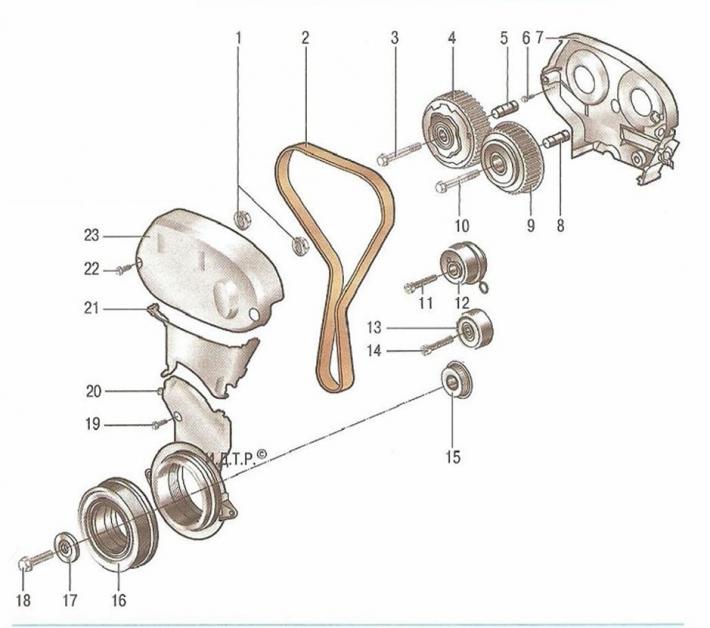
Pic. 5.21. F18D engine timing drive: 1 - plug device for adjusting the position of the camshaft; 2 - timing belt; 3, 6, 10, 11, 14, 18, 19, 22 - bolts; 4, 9 - adjustable camshaft pulleys; 5.8 - threaded plugs for camshaft adjusters; 7 - rear cover of the timing belt; 12 - timing belt tensioner; 13 - intermediate roller; 15 - toothed pulley of the crankshaft; 16 - crankshaft pulley; 17 - pressure washer of the crankshaft; 20 - lower front cover of the timing belt; 21 - middle front cover of the timing belt; 23 - upper front cover of the timing belt
The engine has rotating camshaft sprockets 4 and 9. Continuous adjustment of the camshaft pulleys is carried out by engine oil pressure. Two solenoid valves 33 (pic. 5.22) regulate the oil pressure in the adjustable camshaft pulleys in accordance with commands from the engine control unit. The valve actuator is equipped with piston tappets 29. The valve clearance is adjusted by installing the appropriately sized valve tappets. The engine uses conical valve springs 26. Due to the conical shape, the back pressure of the valve springs increases when they are compressed by the valve lifter, which allows the valve, after passing the bottom dead center of the camshaft cam, to immediately close again due to the inertia of conventional springs.
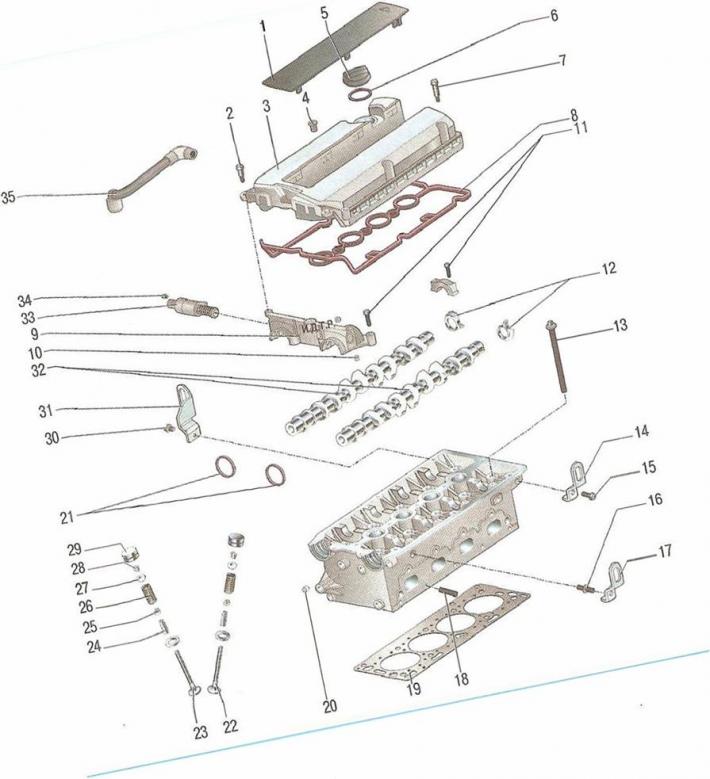
Pic. 5.22. 1.8L F18D Engine Cylinder Head: 1 - cover of the DIS ignition module; 2, 7, 11, 15, 16, 30, 34 - bolts; 3 - cylinder head cover; 4, 10, 20 - plugs; 5 - oil filler plug; b - cork sealing gasket; 8 - sealing gasket of the cylinder head cover; 9 - front cover of camshaft bearings; 12 - camshaft position sensor exciter; 13 - hairpin of a head of cylinders; 14, 17, 31 - transport eyes; 18 - finger of the exhaust manifold; 19 - cylinder head gasket; 21 - front camshaft seals; 22 - exhaust valve; 23 - inlet valve; 24 - valve guide; 25 - valve plate; 26 - valve springs; 27 - valve plate; 28 - oil seal of the valve stem; 29 - pusher; 32 - camshafts; 33 - electro-hydraulic valve; 35 - forced crankcase ventilation hose
cylinder head made of aluminum alloy according to the transverse cylinder purge pattern (inlet and outlet ports are located on opposite sides of the head). Seats and valve guides are pressed into the heads. Inlet 23 and outlet 22 valves each have one spring 26 fixed through plates 25 and 27.
Camshafts 32 are installed in the bed of bearings, made in the body of the head, and secured with covers. The camshafts through the shims act on the pushers 29, which move the valves. The plane of the connector of the head and cylinder block is sealed (1 laying 19 of two plates molded from thin sheet metal and welded together by spot welding.
Cylinder block 7 (pic. 5.23) is a single casting forming cylinders, a cooling jacket, the upper part of the crankcase and five crankshaft bearings made in the form of crankcase baffles. The block is made of special ductile iron with cylinders bored directly in the body of the block. Caps 19 main bearings, machined in assembly with the block, are not interchangeable. Moreover, the covers of the 1st and 2nd, as well as the 4th and 5th main bearings are made in the form of paired blocks, the covers of which are united by jumpers. These jumpers play the role of additional amplifiers that serve to increase the rigidity of the cylinder block. On the cylinder block, special lugs, flanges and holes for fastening parts, assemblies and assemblies, as well as channels of the main oil line are made. From below, the cylinder block is closed by an oil sump cast from an aluminum alloy. The plane of the connector of the cylinder block and the oil sump is sealed with sealant, there is no removable gasket.
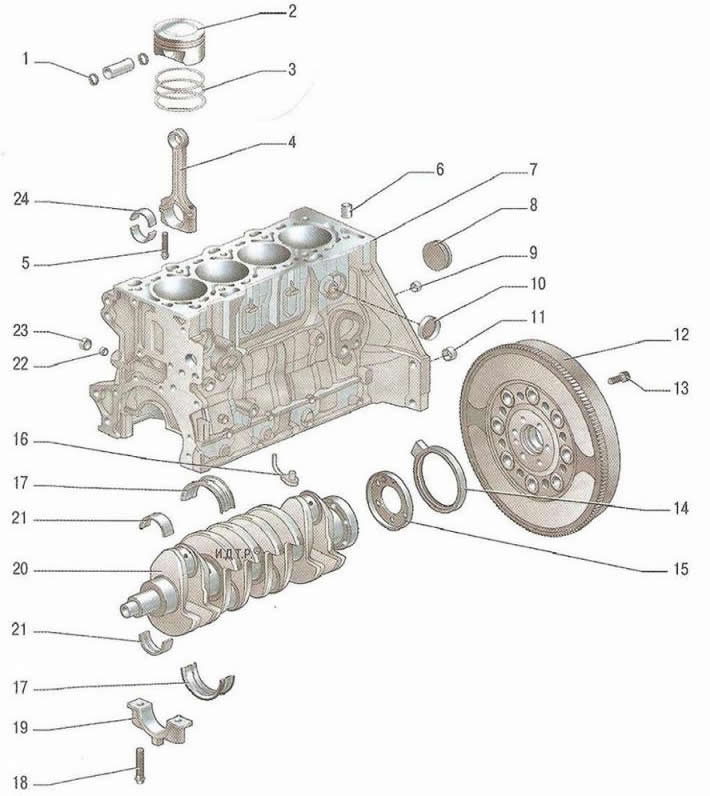
Pic. 5.23. Cylinder block, crankshaft, flywheel and oil sump of the F18D engine with a volume of 1.8 liters: 1 - piston pin retainer; 2 - piston; 3 - piston rings; 4 - connecting rod; 5,13,18 - bolts; 6,9,11 - mounting sleeves; 7 - cylinder block; 8 - plug of the oil channel; 10 - plug of the channel for water; 12 - flywheel; 14 - rear crankshaft oil seal; 15 - master disk of the sensor; 16 - piston oil nozzle; 17.21 - liners of main bearings of the crankshaft; 19 - main bearing caps; 20 - crankshaft; 22 - oil check valve; 23 - oil check valve plug; 24 - lower and upper connecting rod bearings
The position of the crankshaft and the number of revolutions are read from the magnetic ring of the setting disk of the crankshaft speed sensor (pic. 5.24). The setting disk is structurally integrated with the stuffing box 14 (see fig. 5.22) crankshaft.
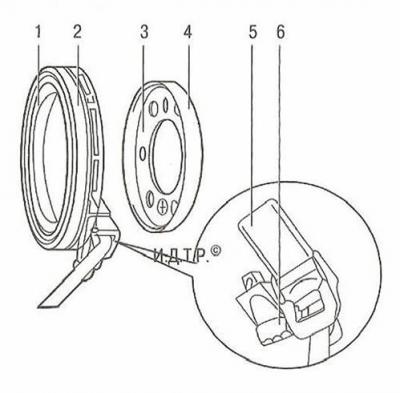
Pic. 5.24. Installation diagram of the crankshaft speed sensor: 1 - sealing edge of the crankshaft oil seal; 2 - outer sealing surface of the crankshaft seal; 3 - working edge of the disk; 4 - setting disk; 5 - crankshaft sensor; 6 - crankshaft sensor mounting bolt
Crankshaft, made of steel, rotates in main bearings with thin-walled steel liners 17 (see fig. 5.23) with anti-friction layer.
Flywheel 12, cast iron, mounted on the rear end of the crankshaft and secured with six bolts. A gear rim is pressed onto the flywheel for starting the engine with a starter. On cars with an automatic transmission, instead of a flywheel, a torque converter drive disc is installed.
Pistons 5 (pic. 5.25) made of aluminum alloy. On the cylindrical surface of the piston head there are annular grooves for the rings: two compression rings 2 and 3, as well as an oil scraper 4.
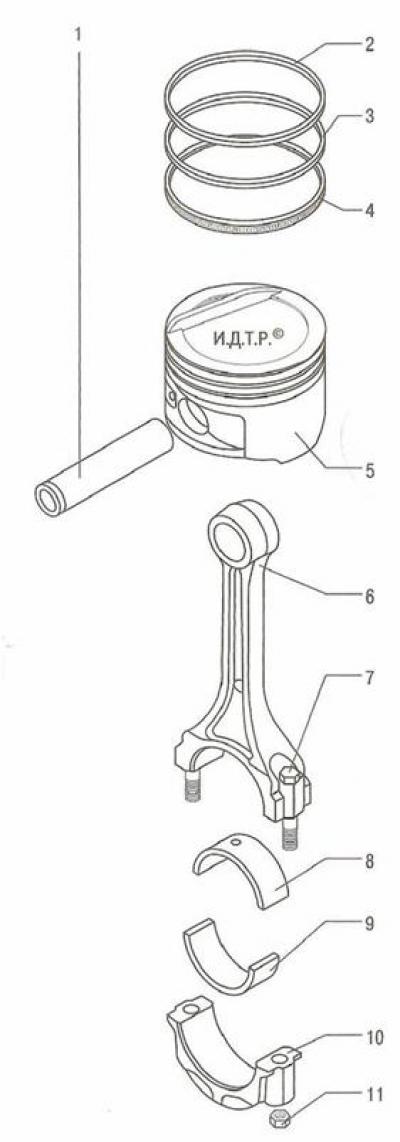
Pic. 5.25. Connecting rod and piston group of the F18D engine with a volume of 1.8 liters: 1 - piston pin; 2 - top compression ring; 3 - lower compression ring; 4 - oil scraper ring; 5 - piston; 6 - connecting rod; 7 - connecting rod bolt; 8, 9 - connecting rod bearing shells; 10 - connecting rod cover; 11 - connecting rod bolt nut
The piston pins 1 are installed in the bosses of the pistons with a gap and are pressed with an interference fit into the upper heads of the connecting rods 6, which are connected with their lower heads to the connecting rod journals of the crankshaft through thin-walled liners 8 and 9, the design of which is similar to that of the main bearings.
connecting rods steel, forged, with an I-section rod.
Lubrication system combined: the most loaded parts are lubricated under pressure, and the rest - either by directed spraying, or by spraying oil flowing from the gaps between the mating parts. The pressure in the lubrication system is created by gear oil pump 5 (pic. 5.26), mounted outside in front of the cylinder block and driven from the front end of the crankshaft. The pump is made with internal trochoidal gearing.
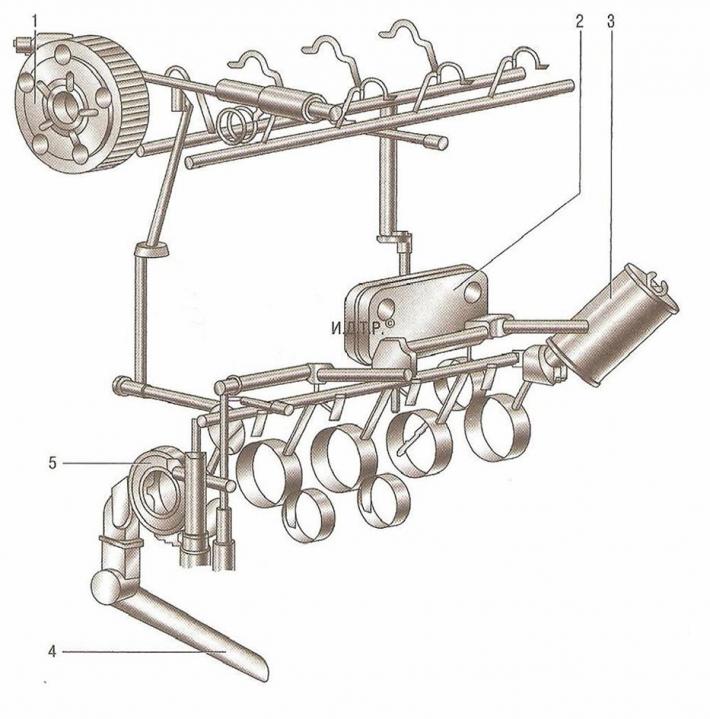
Pic. 5.26. Lubrication circuit for 1.8L F18D engine: 1 - camshaft position regulator; 2 - oil cooler; 3 - oil filter; 4 - oil receiver; 5 - oil pump
The pump sucks oil from the engine oil sump through the oil receiver 4 with a strainer, and then through a full-flow oil filter with a porous paper filter element, it delivers it to the main oil line located in the body of the cylinder block. Oil supply channels to the main bearings of the crankshaft depart from the main line. Oil is supplied to the connecting rod bearings through channels made in the body of the crankshaft. A vertical channel for supplying oil to the camshaft bearings departs from the main oil line. In addition, from the main engine oil line, oil is supplied under pressure to the variable valve timing system and to the camshaft position regulators. To lubricate the camshaft bearings, oil from the vertical channel enters the central axial channels of the camshafts through a radial hole in the neck of one of the bearings and is distributed through them to the rest of the bearings.
The camshaft cams are lubricated with oil coming from the central axial channels through the radial holes in the cams. In addition, nozzles for lubricating the pistons are installed in the cylinder block. Excess oil is drained from the head of the block into the oil sump through vertical drainage channels.
Crankcase ventilation system closed type does not communicate directly with the atmosphere, therefore, simultaneously with the exhaust of gases in the crankcase, a vacuum is formed in all engine operating modes, which increases the reliability of various engine seals and reduces the emission of toxic substances into the atmosphere.
The system consists of two branches: large and small.
When the engine is idling and at low load modes, when the vacuum in the intake pipe is high, crankcase gases are sucked in by the intake pipe through the crankcase ventilation valve installed in the cylinder head cover. The valve opens depending on the vacuum in the intake pipe and thus regulates the flow of crankcase gases.
In full load modes, when the throttle is open at a large angle, the vacuum in the intake pipe decreases, and in the air supply sleeve increases. In this case, crankcase gases through a large branch hose connected to a fitting on the block head cover mainly enter the air supply hose, and then through the throttle assembly into the intake pipe and engine cylinders.
Cooling system sealed, with expansion tank 4 (pic. 5.27), consists of a cooling jacket, made in casting and surrounding the cylinders in the block, the combustion chambers and the gas channels in the cylinder head. Forced circulation of the coolant is provided by a centrifugal water pump 6 driven by a crankshaft poly V-belt, which simultaneously drives the generator. To maintain the normal operating temperature of the liquid in the cooling system, thermostat 11 is installed, which closes a large circle of the system when the engine is cold and the coolant temperature is low.
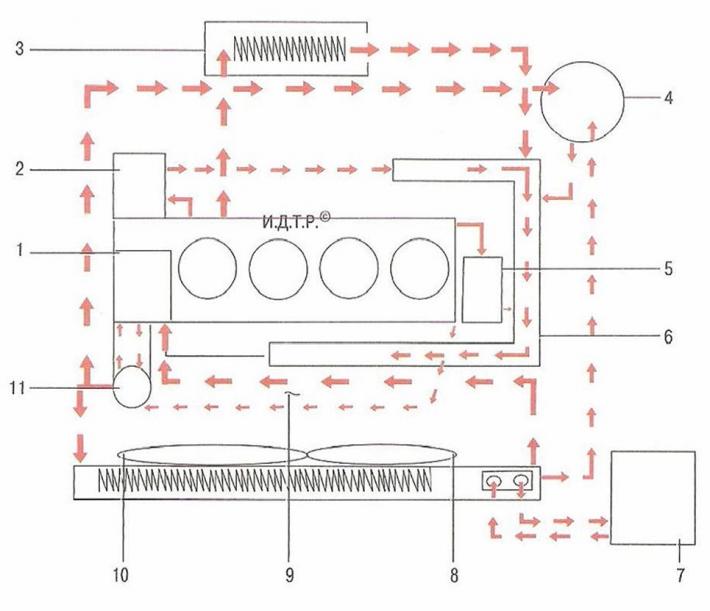
Pic. 5.27. Cooling system: 1 - coolant pump; 2 - engine oil cooler; 3 - heater; 4 - expansion tank; 5 - cooler of the exhaust gas recirculation system (EGR); 6 - water pump; 7 - gearbox in a block with a drive axle; 8 - auxiliary cooling fan; 9 - inlet pipe; 10 - main cooling fan; 11 - thermostat
Supply system consists of an electric fuel pump installed in the fuel tank, a throttle assembly, a fine fuel filter installed in the fuel pump module, a fuel pressure regulator, injectors and fuel lines, and also includes an air filter.
The engine has a plastic two-stage intake module (pic. 5.28). Depending on the engine operating mode, the air is directed in the plastic intake module through one of two intake ducts that differ in length. The intake tracts are switched by a drum built into the plastic intake module. The use of a changeover drum for the pressure of the intake ports reduces the flow resistance in the plastic intake module at high engine speeds.
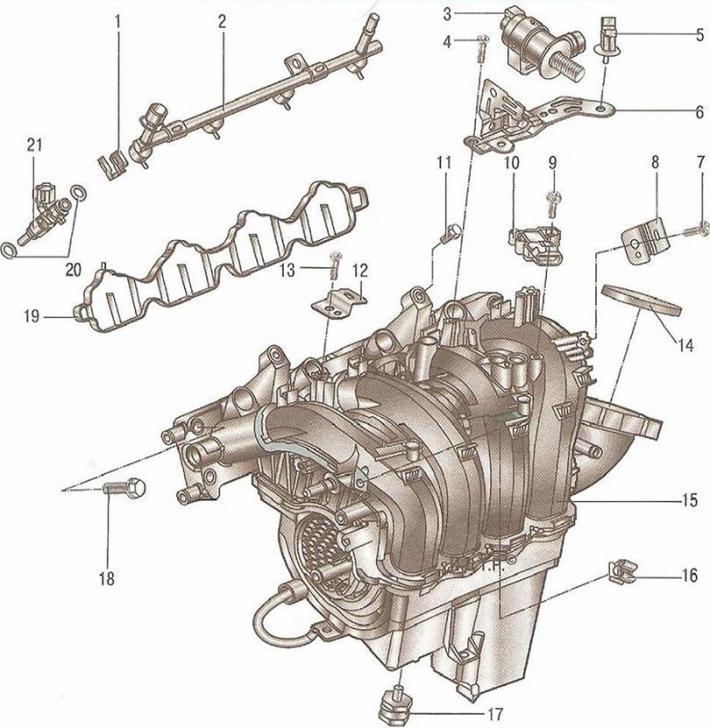
Pic. 5.28. intake pipe: 1 - locking bracket; 2 - fuel rail; 3 - adsorber purge valve; 4, 7, 9, 11, 13, 18 - bolts; 5 - clamp of the bracket of the gasoline vapor recovery system; 6 - bracket for the fuel vapor recovery system; 8 - fastening the ECM wiring harness; 10 - absolute pressure sensor; 12 - fastening the ECM wiring harness; 14 - sealing ring of the throttle body; 15 - inlet pipe; 16 - clamp of the inlet hose for heating the throttle body; 17 - intake pipe retainer; 19 - gasket between the intake pipe and the cylinder head; 20 - sealing ring of the fuel injector; 21 - fuel injector
The throttle body is mounted on the side of the plastic intake module, which allows optimal positioning of the individual sections of the intake pipe and reduces the loss of air flow from the air filter to the intake valves. In this case, the cross section of the pipe remains constant along the entire length of the intake tract. The throttle branch pipe is sealed with a rubber ring 14.
Ignition system microprocessor, consists of an ignition coil, high-voltage wires and spark plugs. The ignition coil is controlled by the electronic engine control unit. The ignition system during operation does not require maintenance and adjustment.
power unit (engine with gearbox, clutch and final drive) mounted on four supports with elastic rubber elements: two upper side (right and left), perceiving the bulk of the power unit, as well as the rear and front lower ones, compensating for the torque from the transmission and the loads that occur when the car starts off, accelerates and brakes.
A distinctive feature of the F18D engine is the presence of an electronically controlled variable valve timing system on both camshafts (DCVCP). This system allows you to set the optimal valve timing for each moment of engine operation, which, in turn, achieves increased power, better fuel efficiency and lower exhaust emissions.
On front cover 9 (pic. 5.22) bearings of the camshafts, electro-hydraulic valves 33 are installed, which continuously regulate the camshafts. Camshaft adjustment provides an additional means of controlling the engine in the event of a change in load. At idle, engine speed is reduced and performance is optimized by setting minimum valve overlap. In partial load mode, the position and length of the valve overlap time are changed to ensure low fuel consumption and minimum emissions. In full load mode, an increase in maximum torque and power is achieved by optimizing the intake valve closing timing. The position of the intake camshaft changes within 60°of the crankshaft angle.
When the intake camshaft «late», the content of residual gases in the cylinder is reduced, since the overlap of the intake and exhaust valves is also reduced. This means that the cylinder is filled predominantly with fresh mixture.
